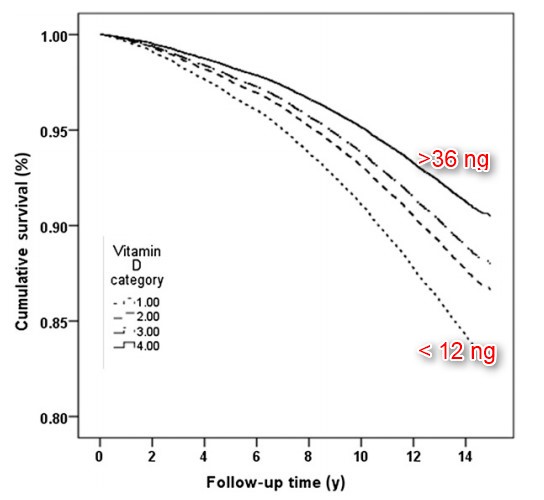More vitamin D makes for better health – dissertation based on Rotterdam studies
Vitamin D and cardio-metabolic health in the elderly, The Rotterdam study
Dissertation by Anna Vitezova, which includes many of her publications
 click on image for details
Pages in VitaminDWiki listed in BOTH of the categories Diabetes and Magnesium
{category}
click on image for details
Pages in VitaminDWiki listed in BOTH of the categories Diabetes and Magnesium
{category}
📄 Download the PDF from VitaminDWiki
Chapter 1 of this thesis introduces the reader to the background of the main topic – vitamin D, its metabolism and physiological effects. Since its discovery vitamin D has been recognized as an important factor in calcium homeostasis and bone metabolism. Recently, there has been extensive research performed on possible extra-skeletal effects of vitamin D. Nowadays vitamin D deficiency has been linked to a higher risk of many prevalent diseases such as cardio-vascular disease or type 2 diabetes mellitus. Based on this new research it is considered that improving vitamin D status may be a cost-effective tool to improve public health. The main objective of this thesis was to investigate the association of vitamin D and cardio-metabolic health.
Chapter 2 presents a systematic review and meta-analysis of observational studies and randomised controlled trials (RCTs) on vitamin D and the risk of mortality . The objective was to evaluate the extent to which circulating biomarker and supplements of vitamin D are associated with mortality under various circumstances. With this meta-analysis we found that the evidence from observational studies shows inverse associations of circulating 25-hydroxyvitamin D with risks of vascular, cancer and nonvascular-noncancer deaths. Further we found that supplementation with vitamin D3 reduces overall mortality among older adults significantly; however, further investigations are required to establish the optimal dose and duration, and whether vitamin D3 affects mortality risk differently than vitamin D2.
In chapter 3 we investigated the associations between vitamin D and metabolic outcomes. More specifically, in chapter 3.1 we focused on possible association between vitamin D status and prevalence of metabolic syndrome in the elderly since the findings on this topic in the elderly are inconsistent. The aim was to evaluate the association between vitamin D status and the metabolic syndrome in the elderly, as well as between vitamin D status and the components of metabolic syndrome (i.e. serum glucose, triglycerides (TG), HDL cholesterol (HDL-C), waist circumference (WC), and blood pressure (BP)). We found higher 25-hydroxyvitamin D concentrations in the elderly to be associated with a lower prevalence of metabolic syndrome and, in particular, with more beneficial HDL-C, TG, WC and serum glucose. Further in this chapter (3.2) we examined the association between vitamin D and body composition in the elderly. We found lower serum 25-hydroxyvitamin D concentrations to be associated with a higher fat mass Vitamin D and Cardio-metabolic Health in the Elderly percentage. We also demonstrated that the association between serum 25-hydroxyvitamin D and differential fat distribution in the elderly was mainly explained by BMI, which deserves further study.
The focus of chapter 4 was on the association of vitamin D and cardiovascular health. Here we investigated the possible association between vitamin D status and the incidence of atrial fibrillation in the elderly. We found vitamin D status not to be associated with atrial fibrillation in any of the 3 multivariate models tested and concluded that this prospective cohort study did not support the hypothesis that vitamin D status is associated with atrial fibrillation.
Chapter 5 introduces new ideas in the vitamin D research. Firstly, we have investigated the possible interaction between serum magnesium levels and vitamin D in relation to incidence of type 2 diabetes mellitus (5.1). We found that the association between 25-hydroxyvitamin D and type 2 diabetes mellitus may depend on adequate serum magnesium levels. These results imply that it may be important in clinical practice to assess serum 25-hydroxyvitamin D and magnesium levels simultaneously to identify people at risk of type 2 diabetes mellitus. In the second part of chapter 5 (5.2), we explored the association between vitamin D and serum lipids. Higher levels of vitamin D have been associated with lower rates of cardiovascular disease perhaps through improved lipid profiles. However, results reported were inconsistent and the direction of the association between vitamin D and lipid levels remained unknown. For that reason the aim of this chapter was to assess the potential bidirectional associations between 25-hydroxyvitamin D and blood lipids using path analyses in cross-lagged models a novel approach in analyzing this kind of data. Our results from path analyses on repeatedly measured 25-hydroxyvitamin D and lipid levels suggest that total cholesterol might be related with a decrease in 25-hydroxyvitamin D concentrations, but not the other way around, whereas the observed inverse association between HDL cholesterol and 25-hydroxyvitamin D may be bidirectional.
Chapter 6 discusses the main findings of this thesis as well as methodological issues arising from the design of our study, public health implications of our findings and future directions in vitamin D research. Repletion of vitamin D status might be considered as a cost-effective public health measure in prevention of certain conditions and improving some aspects of overall human health. However, to prove the causality of the association of vitamin D Vitamin D and Cardio-metabolic Health in the Elderly and different diseases with the certainty, properly designed randomized controlled trials are needed.
